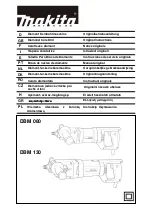
9
NOTE:
•
Make sure that the driver bit is inserted straight in
the screw head, or the screw and/or bit may be
damaged.
•
When driving wood screw, predrill a pilot hole 2/3
the diameter of the screw. It makes driving easier
and prevents splitting of the workpiece.
•
If the tool is operated continuously until the battery
cartridge has discharged, allow the tool to rest for
15 minutes before proceeding with a fresh battery.
Drilling operation
CAUTION:
•
Pressing excessively on the tool will not speed up
the drilling. In fact, this excessive pressure will only
serve to damage the tip of your bit, decrease the
tool performance and shorten the service life of the
tool.
•
There is a tremendous force exerted on the tool/bit
at the time of hole break through. Hold the tool
firmly and exert care when the bit begins to break
through the workpiece.
•
A stuck bit can be removed simply by setting the
reversing switch to reverse rotation in order to back
out. However, the tool may back out abruptly if you
do not hold it firmly.
•
Always secure small workpieces in a vise or similar
hold-down device.
•
If the tool is operated continuously until the battery
cartridge has discharged, allow the tool to rest for
15 minutes before proceeding with a fresh battery.
First, slide the action mode change lever so that it points to
the
marking. The adjusting ring can be aligned in any
torque levels for this operation. Then proceed as follows.
Drilling in wood
When drilling in wood, the best results are obtained with
wood drills equipped with a guide screw. The guide screw
makes drilling easier by pulling the bit into the workpiece.
Drilling in metal
To prevent the bit from slipping when starting a hole, make
an indentation with a center-punch and hammer at the
point to be drilled. Place the point of the bit in the
indentation and start drilling.
Use a cutting lubricant when drilling metals. The
exceptions are iron and brass which should be drilled dry.
MAINTENANCE
CAUTION:
•
Always be sure that the tool is switched off and the
battery cartridge is removed before attempting to
perform inspection or maintenance.
•
Never use gasoline, benzine, thinner, alcohol or the
like. Discoloration, deformation or cracks may
result.
Replacing carbon brushes
Fig.17
Replace when they wear down to the limit mark. Keep
the carbon brushes clean and free to slip in the holders.
Both carbon brushes should be replaced at the same
time. Use only identical carbon brushes.
Fig.18
Use a screwdriver to remove two screws then remove
the rear cover.
Fig.19
Raise the arm part of the spring and then place it in the
recessed part of the housing with a slotted bit
screwdriver of slender shaft or the like.
Fig.20
Use pliers to remove the carbon brush caps of the carbon
brushes. Take out the worn carbon brushes, insert the
new ones and replace the carbon brush caps in reverse.
Fig.21
Make sure that the carbon brush caps have fit into the
holes in brush holders securely.
Reinstall the rear cover and tighten two screws securely.
To maintain product SAFETY and RELIABILITY, repairs,
any other maintenance or adjustment should be
performed by Makita Authorized Service Centers, always
using Makita replacement parts.
OPTIONAL ACCESSORIES
CAUTION:
•
These accessories or attachments are
recommended for use with your Makita tool
specified in this manual. The use of any other
accessories or attachments might present a risk of
injury to persons. Only use accessory or
attachment for its stated purpose.
If you need any assistance for more details regarding
these accessories, ask your local Makita Service Center.
•
Drill bits
•
Hammer drill bits
•
Screw bits
•
Blow-out bulb
•
Safety goggles
•
Makita genuine battery and charger
•
Grip assembly
•
Depth rod
•
Hook
•
Rubber pad assembly
•
Wool bonnet
•
Foam polishing pad
•
Battery protector
NOTE:
•
Some items in the list may be included in the tool
package as standard accessories. They may differ
from country to country.










































